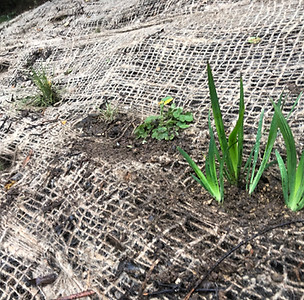Preserving Your Property:
Reducing Erosion
When it comes to sustainability, preserving your property is priority number one.
Preventing erosion on steep slopes is important, especially during planting season. Here are 5 steps to help.
After extensive broom removal to create a fuel break last year, It’s time for native plantings at this Marin County property in Larspur.

Step 1. First, weed out everything on the slope. In this case, Erharta. A bold move during the rainy season that requires moving fast and being prepared to cover it up quickly.

Step 2. Here we lay down some organic debris from the area. This is in order to buffer the bare dirt from rainfall, reduce weeds, cover bare mud, and minimize compaction while planting.

Step 3. Here we roll out jute netting fabric on the grade. Remember to overlap the edges and fold over the ends to prevent a ragged edge. We use landscape staples about every 5 feet, and each corner.

Step 4. Now we lay out plants. We put the largest plants in the flattest places. Planting through the holes in the jute netting is a little tricky; you will want a small shovel or trowel.

Step 5. We use the smallest plants (for us fescue grasses in leech tubes) on the steepest slopes. We used a digging bar to punch holes to reduce soil disturbance rather than digging.
Plants from our nursery included:
-
Idaho fescue
-
Red fescue
-
California fescue
-
Douglas iris
-
Horkelia
-
California aster
-
Western vervain, among others
These plants perform various functions, including reducing erosion, minimizing fuel load, and providing food and habitat for pollinators and wildlife.
